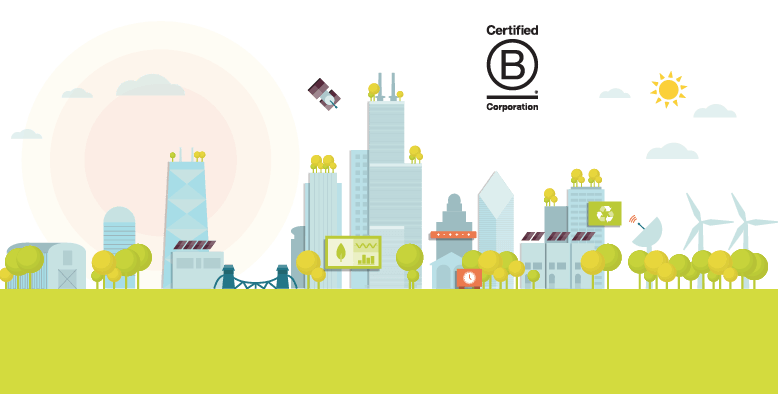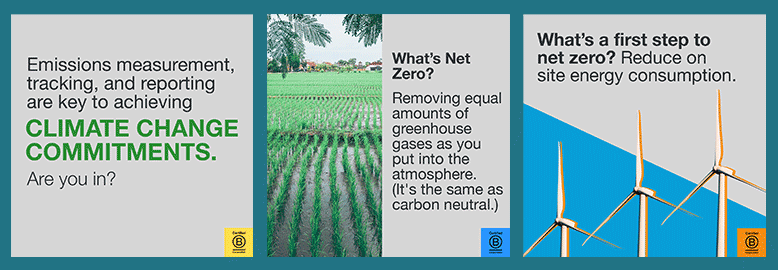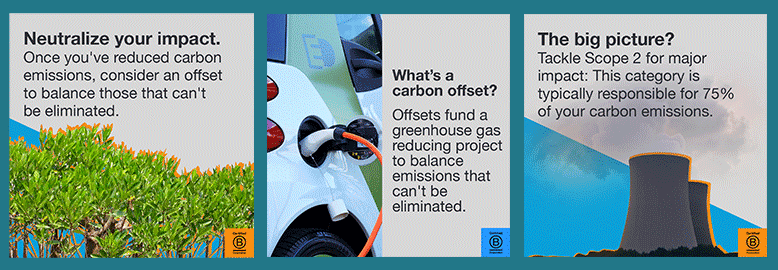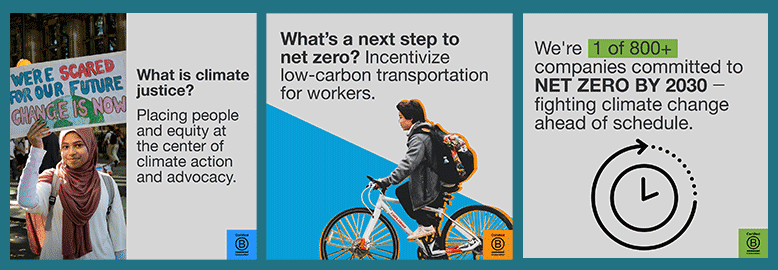What is ‘Net Zero’ for a Digital Business?

In this post, we explore what Net Zero targets mean for digital businesses. We also share some ways digitally-enabled organizations can work toward meaningful climate goals.
Accelerated climate change and ecological breakdown have already impacted every corner of our globe and directly affected organizations of all sizes. As climate change accelerates, one by-product is increasing social inequities and inequality. Eventually, this will lead to disruption and social unrest on a scale we’ve never seen before.
Per the B Corp Climate Collective:
It is clear to us that these twin crises are being driven, and responses constrained, by an economic system that rewards the single-minded pursuit of profits while untenably externalising environmental and social costs. This results in decisions that prioritize short term financial returns often at the expense of people, communities, and the natural world on which all life depends.
In a nutshell, this is why we’re a Certified B Corp. We believe there’s a better way forward.
Mightybytes declared a climate emergency in January 2020 and committed to achieving Net Zero emissions as quickly as possible. While we have worked to reduce the company’s environmental impact for over a decade now, we made significant progress toward achieving our zero emissions goal since the pandemic started. Here’s how.
What we Mean by ‘Digital Business’
Digital products and services now enable most organizations. While nearly every business is a digital business in some way, those that operate exclusively digital practices face a unique set of challenges when it comes to creating meaningful climate impact. This is especially true when it comes to artificial intelligence, which carries with it significant ethics and sustainability challenges.
Agencies, virtual companies, SaaS product platforms, digital service providers, and many nonprofit organizations that commit to achieving Net Zero will quickly find gaps in the data they can use to make progress against their commitments. It’s hard to track and measure digital emissions, and especially challenging for Scope 3 emissions.
Plus, measuring the environmental impact of artificial intelligence is currently where web-based products and services were ten years ago—the tools and resources to do this simply don’t exist yet. However, this will change quickly.

What is Net Zero?
Committing to Net Zero means that your organization will first reduce carbon emissions as much as possible, then offset what can’t be reduced to reach the equivalent of zero emissions. The B Corp Climate Collective recommends that companies wanting to make a Net Zero commitment follow these steps:
- Declare a Climate Emergency: Use the Climate Emergency Playbook for Business to encourage stakeholders and claim intent.
- Accelerate Carbon Reduction: Estimate Scope 1-3 emissions and devise a plan to reduce them as much as possible.
- Develop a Net Zero Plan: Offset remaining emissions to achieve Net Zero as quickly as possible.
- Join the B Corp Climate Collective: This global community of learning and practice is dedicated to climate justice and advocacy.
The group also recommends engaging in ongoing climate advocacy and using the community’s collective voices to accelerate the just transition to a net zero carbon economy. (In other words, your actions don’t stop by joining the collective.)
Of course, if you’re not a B Corp, the first three steps above still apply to your organization. Also, there are plenty of other ways your organization can build community to take action. The key is to foster collaboration among a wider ecosystem of stakeholders.
Defining Emissions Scopes
Understanding how to approach a Net Zero commitment means understanding the differences in emission types, which are broken into three categories:
- Scope 1: Direct emissions from company-owned and controlled resources, including onsite HVAC units, company vehicles, industrial processes, etc.
- Scope 2: Indirect owned emissions from energy purchases
- Scope 3: Indirect not-owned emissions from a company’s upstream and downstream activities
Organizations should include all three emissions scopes in their reporting, though many regulatory guidelines only list scopes one and two as mandatory. This should change to include all three scopes.
Scope Three Emissions
There are 15 categories under Scope 3 emissions that include purchased goods and services, operations waste, transportation and distribution, leased assets, and so on. Scope 3 emissions offer the widest number of opportunities for organizations to make progress on their Net Zero commitment.
However, because Scope 3 emissions are often associated with an organization’s supply chain and out of its control, they can also be the most difficult to calculate and track. Digital emissions mostly fall under Scope 3, hence the challenge for businesses tracking emissions in their digital supply chains. These emissions could come from SEO efforts or they could come from website plugins or even bots that crawl your site.
Further complicating this, the Science Based Targets Initiative (SBTi), which provides ICT sector guidance on Net Zero initiatives only currently supports companies operating mobile networks, fixed networks, and/or data centers. Other digital businesses will need to look elsewhere for resources.
We worked on the Sustainable Web Design model with for estimating emissions—with Wholegrain Digital, the Green Web Foundation, Footsprint, and others—for this very reason. This model is now used in dozens of products and services, including our own Ecograder and the Green Web Foundation’s CO2.js.

Reduce Emissions First
In making a Net Zero commitment, organizations are encouraged to first reduce as many emissions as possible before resorting to carbon offsets and/or renewable energy credits (RECs). For virtual and digital-first businesses, this can be challenging.
Before Mightybytes became a Certified B Corp in 2011, we were members of Eco-Andersonville and went through their green business certification in 2009. Thus, reducing waste and improving our environmental impact has been a company priority for many years. However, most of this work falls under Scopes 1 and 2 above. We still struggle to accurately track and reduce Scope 3 emissions.
Emissions We Reduced
The commitments mentioned above made reducing our carbon footprint easier. These included:
- Energy Star-compliant appliances and HVAC units that use less electricity
- Nest thermostats to better regulate office temperatures, especially after-hours
- Intelligent plugs that can be controlled through wifi to shut off automatically, reducing “vampire power”
- Reducing business travel, encouraging public transportation use and low-carbon commuting, such as walking or cycling
- Cree LED bulbs in every office socket to reduce electricity consumption
- In-house composting, which we later replaced with a zero-emissions composting service
- Ordering supplies from companies (usually other B Corps) that offer low-carbon shipping options and buying recycled, composted, or low-impact materials when possible
This isn’t a comprehensive list, but it represents the primary things Mightybytes did to reduce our emissions over the years. Unfortunately, we changed offices several times and didn’t set a baseline, so it’s hard for us to quantify how much we have improved over the years. Lesson learned.

Offset What You Can’t Reduce to Pursue Net Zero
Elements out of our control also hinder the company’s specificity regarding science-based targets. When we had an office, for example, our building unit didn’t include an electricity meter. To accommodate, we estimated energy use based on square footage and similar usage rates from other units our size on Chicago’s north side. It wasn’t a perfect approach, but served as a viable workaround.
Similarly, many third-party digital services we invest in don’t provide meaningful data points for calculating emissions or energy use associated with our account. Digital platforms often consider this data as ‘proprietary’ and don’t share. However, emerging laws and policies related to climate disclosures will change this.
In other words, if you run a podcast, use a third-party hosting provider, embed a font into your website, or subscribe to any number of digital services to run your business, you’ll quickly hit a wall. For digital businesses to accurately track and reduce all emissions—especially Scope 3—this has to change.
The Challenge with Offsets
Often, the best we can do to estimate these emissions is guess based on existing published information. By “rounding up” estimates, we can hope that carbon offsets and renewable energy credits (RECs) purchased more than cover our footprint.
However, offset-based solutions face many challenges, not the least of which is significant greenwashing. You also need to be sure the offsets and RECs you choose effectively reduce emissions and support the rapid proliferation of renewable energy.
COVID and Carbon Emissions
In March 2020, like many businesses, the global COVID-19 pandemic forced our team to work remotely. Because of this, we were able to drastically reduce annual office energy use. Once we became a virtual company, we also adjusted the components above to compensate for reduced commuting, business travel, and home offices.
Artificial Intelligence and Emissions
What’s more, tracking and reducing your own emissions related to your organization’s use of Generative AI is currently next to impossible:
- AI companies don’t disclose specific data related to customers’ use of their tools.
- Similarly, the energy, resource, and water use, as well as emissions produced, when training Large Language Models (LLMs) necessary to provide AI tools is not typically publicly available, though, again, this change change with emerging climate disclosure laws.
- Plus, the privacy and disinformation ramifications of using these tools lead to untold data inequality and social justice issues.

Scope 3 Emissions: It’s Complicated
Expect data sustainability to be a major keystone in companies’ climate-change goals over the next decade.
—Wunderman Thompson Intelligence, February 2021
Many organizations struggle to define and reduce emissions associated with Scope 3, which includes upstream and downstream activities. Most emissions associated with digital products and services fall into the following Scope 3 categories:
- Category 1: Purchased Goods and Services
- Category 11: Use of Products Sold
Unfortunately, as noted above, it is very difficult to get meaningful data from third-party digital platforms for Scope 3 emissions.
At Mightybytes, we use sustainable web design practices and our web sustainability tool Ecograder to reduce emissions when building digital products and services for clients. As part of our Impact Business Model in this area, we’re working to better define, measure, and baseline client websites before and after a redesign. However, some of the services we use won’t provide useful data for these efforts, which is frustrating.
Green Web Hosting: It’s Complicated
Similarly, it’s also hard to find good green website hosting companies that embrace open data and transparency around how they power their data centers. Plus, what these companies offer in sustainability commitments, they often lack in other important areas, like cost, customer service, uptime, security, and so on.
Unfortunately, this represents a long and sometimes painful journey to offer our clients truly green, emissions-free website hosting.

Moving Forward: Net Zero Obstacles
Mightybytes is lucky. Our small team and digital-specific business model means that reducing and offsetting emissions isn’t as arduous as it might be for larger product-based companies with complex supply chains. We don’t purchase a lot of goods and services. We don’t travel much for business. Plus, now that we’re virtual, we barely commute. This enables us to make progress on Net Zero commitments faster than most.
However, as a small company, many factors are also outside our control. There are still gaps in the data we can get for Scope 3. Again, this is especially true for artificial intelligence. Plus, we don’t have the resources to positively impact them, which presents ongoing challenges.
Still, there are areas where we can improve our efforts:
- We can learn more about how to set and maintain science-based targets.
- The company can always improve our Sustainable Web Design practice.
- Also, we can continue to improve Ecograder to help others better understand these concepts.
- Finally, we can advocate for better legislation that will encourage digital platforms to disclose their energy data.
An Always Moving Target
Compounding this, Net Zero is an always moving target. It’s not a “set it and forget it” endeavor but rather a dynamic process that requires ongoing diligence. In their Net Zero Initiative project, Carbone 4 notes that companies cannot claim carbon neutrality. They can only contribute to it. The objectives are collective, not individual.
Similarly, according to the Science-Based Targets initiative (SBTi):
The use of offsets is not counted as reductions toward the progress of companies’ science-based targets. The SBTi requires that companies set targets based on emission reductions through direct action within their own boundaries or their value chains. Offsets are only considered to be an option for companies wanting to contribute to finance additional emission reductions beyond their science-based target/net-zero.
For more information, Carbon Trust has a great post on why defining Net Zero is so complicated.

Opportunities to Innovate
The greatest opportunities will no longer be found in the overbuilt sector of consumer and business internet applications. Instead, they’ll be found in climate tech…With the innovation that is needed to transform entire businesses and economies to net zero emissions, there will be more billionaires created over the next two decades than during the internet boom.
— Tim O’Reilly, Wired
Some pundits predict that climate change will bring about the next entrepreneurial revolution. Climate tech investment has already increased at five times the venture capital market rate over the last seven years.
I want to be guardedly optimistic about this. While entrepreneurial innovation is great, it has to be grounded in clear climate priorities. It cannot succumb to greed and other adverse consequences of traditional capitalistic growth models. Climate change is the existential crisis of our times. We need to treat it as such.
How Our Digital Agency Looks at Net Zero
Based on the math we did and my current understanding of Net Zero commitments, Mightybytes is heading in the right direction. We have a baseline and a clear path to improve our efforts. Net Zero is an always moving target that requires ongoing vigilance in the face of changing circumstances. We’ll need to revisit our commitment regularly. We’ll learn what needs to change, then execute those changes over time.
For these reasons plus the potential damage that relying on offsets could bring to the company’s reputation, I’m hesitant to shout from the highest rooftop that we’re a Net Zero company. However, I’m still proud of our progress and look forward to continuing this work.
We must reach a zero emissions economy as soon as possible. Each company playing their part is critical to making this happen.
Digital Carbon Ratings, now in Ecograder.
Understand how your website stacks up against industry carbon averages with this new feature.
Try Ecograder


